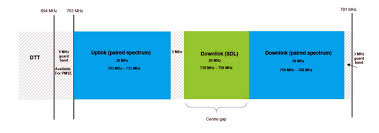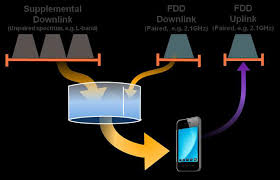Supplementary Download Link


In a normal mobile connection the channel used is a pair of channels, one uplink and one downlink. The model is that the traffic is two way, and there is even capacity for both the uplink and downlink. However much of the use of mobile broadband is to engage with one way traffic such as entertainment services. Here there is significantly more download than upload. With a normal paired setup, the uplink is not being used much whereas the downlink is running near capacity.
The Suplementary Down Link adds more capacity to the downlink. SDL allows the bonding of the unpaired spectrum with a pair of FDD chanels to significntly enhance the download capacity. In the LTE release 10, up to 2 SDL downlinks can be associated with one pair of standard uplink and downlink channels. To achieve the successful use of SDL the UE (mobile phone) must support carrier aggregation. The downlink data will be sent in parallel from the Base Station to the UE, and the UE must be capable of putting the received data together in the correct order; this is carrier aggregation. Most modern high spec smart hones can manage carrier aggregation.
The benefits of using SDL is that it reduces costs to the MNO, where the SDL can add capacity when the paired downlinks are full. The frequencies used for SDL (1.4GHz 1452-1492MHz) can with carrier aggregation have the capacity of the 2.6 LTE bandwidth but the lower frequencies have better indoor reception.
In Europe two areas of the spectrum have been identified as SDL. These are 40MHz band in the 1.4GHz (Band 32) and the 80MHz centre gap in the new 700MHz frequencies for 5G. Within the UK, Vodafone and Three have access to the SDL bandwidth at 1.4GHz. The central gap in the 700MHz frequency has still to be auctioned. So, in the UK only Vodafone and Three customer can benefit from SDL.
*u* ©mobilephonetechnology.co.uk all rights reserved 2017- 2025



